At home, my roommate Ping and I bonded over a special moment in NBA basketball that was unlike anything I’d ever seen before or since. Yo, ya’ll see what that Asian kid from Harvard is doing? He dropped 38 at da Garden last night! New York City had caught a nasty case of Linsanity and we did not want a cure. We didn’t have cable so we watched the Knicks on those sketchy underground streaming sites where you had to intermittently close out semi-pornographic pop-up ads, else you might get a virus. There we were–huddled around my 15 inch Toshiba in my shoddy matchbox of a bedroom, high fiving and hooting and hollering every time #17 got a bucket against the Raptors. Jeremy’s bringing it up the court for the last possession with an 87-87 scoreboard. Clock winding down. Wait..he’s waving off his teammates.
Both of us, nervous: Oh?
He goes into dribble pullup.
OH!?
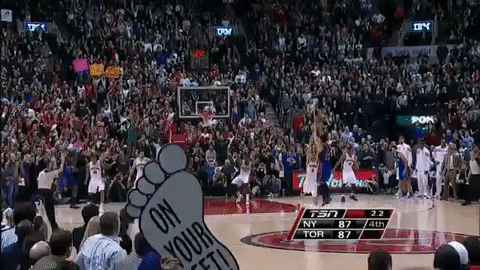
OHHHHHHHHHHHHHHHHHHHHHHHHHHHHHH!!!!
We jumped for joy and then we bro-hugged. Jeremy’s our best friend. He’s our brother. He’s us. HE JUST FUCKING DID IT!
Ping immigrated from Beijing five years ago to study at Michigan then moved to NYC to work in finance. I moved from sunny Orange County to NYC to trade stocks. We saw our hopes and dreams playing out on that basketball court. People expect us Asian-Americans to put their heads down, study hard and become engineers or doctors. We weren’t supposed to take on the world and hit ice cold game-winners. I wanted to defy expectations.
(continued from Low Morale)
I arrived at the office with newfound inspiration. We’re gonna grind that tape and turn it around. Tuco assembled all of us into the conference room and made a quick little speech.
Tuco: Muchachos. Listen up. We didn’t get into this business to make minimum wage. That’s all you’re going to make if we just look for plays where you can risk a few cents. I know you guys are good traders but you just need to open your eyes. We need positions we can hold with confidence. We don’t want trades based on buyer/seller random nonsense where we have no idea what to expect then the algo punishes us. We have to concentrate on what makes a good trade good–what makes them trend and conversely, what makes them go exhaust and then reverse? It’s all about psychology of markets.
We went over basic stuff. The Wyckoff cycle. Stages of fear and greed in investor psychology stycle. We went over news items that propel stocks to become leading names–first profitable earnings quarter, raising guidance, new product, capturing more market share, key acquisitions. We went over breakway gap-ups after a multi-day runup. Tuco sourced a bunch of trade examples from all over–some of the top A5 Capital guys, popular traders in the Stocktwits circle, and elite level prop traders he personally knew from Trillium and FNYS. They wanted to trade large moves. No secret sauces, just bread and butter setups where you’re on the same page as where the stock was going.
Then we talked long about tactics. Adjustments we were going to make:
- Stop placement: stops would be placed at key pivot points such as low of day (if long), high of day (if short), or using key long-term daily on at least a daily/weekly chart. If you wanted more aggressive stops, they need to be clear “pullback” lows in a 30-60 minute chart. The algo’s were getting too good at shaking us out on tight consolidation ranges. We needed to get comfortable with seeing a chart go sour and clearly prove our thesis wrong. Tuco: I can live with ripping up my money on an idea that I like. I get more fucked up being flat when shaken out of a tight stop and then seeing it go my way.
- Stock selection: Be in situations we can understand and expect outcomes to move our way. Stocks should have a story behind them, some combination of investor psychology change (sentiment), short-term news flow/catalysts, and bigger picture trends. Tuco started asking us, how many times does our generic stock trade explode because it held over a level? Why does it so often get over a level only for the price to trickle back down and waffle around? Was our horizontal line placed at the wrong level or were we simply fooling ourselves into thinking that we had a worthwhile analytical model in the first place? Understanding your trades as a bigger piece of a timeless historical/psychological phenomenon, rather than just noise/randomness/chaos, could give you the confidence you needed to stick with the trade in terms of risk and holding period. Let’s be in stocks that move (range/volatility) and not stocks with a 10c range for the last hour because we want to feel safe. Tuco: If you’re scared, get a dog.
- Time horizon: We wanted to focus on catching the meat of the move. If a good earnings play had an opening range of 2 points and trended until the close, you could potentially catch 3-5 points. You can even hold partial amount of a winner overnight (at this point, no one except Tuco was holding positions overnight). No piker nonsense like buying with a 10c buyer and either selling for 20c quickly or hold while being nervous you’ll get dropped out. Let things play out. Tuco wanted to change the psychology of the desk where all of us were scared to give back our initial profits. We didn’t know where stocks could move outside the granular level so we just sold into initial momentum as quickly as we could. The training program materials made it seem like if a stock kept going and we got out early, we could just re-enter safely whenever (it was never that easy). This desire to control the variance of trading greatly limited our potential upside. Tuco: Just let it go.
- VWAP (Volume Weighted Average Price) — I just want to throw this in there — VWAP wasn’t as ubiquitous back then as it is today in the discussion of technical indicators. It was mostly an institutional term used in the context of execution traders or algo’s buying a long-term fund position as efficiency as possible, with the average price measured against VWAP. Eagle and Tuco were two of the first traders I ever knew who started using intraday VWAP and then later on, multi-day VWAP, as key price levels. Tuco suggested we use VWAP as a level to buy strong stocks into pullbacks rather than relying on our random horizontal lines. We saw VWAP as the “average participant’s average price” for the day, thus a key psychological level. Shortly after this, seemingly everyone on the desk put VWAP on this charts.
- Trade around a core position — some people would call it recycling shares, some would call it trading a range. Example: hold 500 shares as a core position to stay in a stock’s trend but also scalp around some levels or momentum to add smaller margins. He said we could slowly ween off our ultra-micro habits by trading around a core rather than trading binary outcome style (exiting full position at only stop or profit target).
Then Tuco asked the rest of us for our input. Given these new adjustments, what type of stocks should we look at going forward?
He looked at me first. Pete, I know you like those junkers. You think those could give us some juice? Tuco and I had been trading the odd penny stock or so the past couple months. He knew my background so he’d ask me what’s the deal about any sub $5 stock on his radar. I chimed in that shorting low floats and penny stocks was becoming a popular strategy because these pump and dump moves had clear short-term cycles with extreme investor psychology. There would be a ton of greed the way up and then a drop back to $0 as fear kicked in after the insiders sold out. Historically, professional trading desks didn’t really touch penny stocks because they were too illiquid. But some of them do break through and actually get to the volume threshold you needed to trade a decently-sized position. I told him I was tracking this one biotech, Galena (GALE). It was under 30c in December but now creeping over $2.50. He told me to keep an eye on these developments.
After that, Eagle suggested we starting trading Apple (AAPL).
AAPL was the hottest tech stock in the world and the most widely-discussed in mainstream outlets. The iPhone had completely changed the cellular market and turned the tech name into a rocketship. How far can AAPL go, everyone asked. There was a Y5 virtual trade cast with live positions, given to us MBC traders as a complimentary feature, and we saw their top traders in AAPL every single day. Yet nobody at MBC ever traded AAPL. A big reason was how the firm setup their risk controls: MBC didn’t want anyone trading so-called “high beta stocks” (stocks with higher range that move more when the market is volatile) until 1 year of experience. Inexperienced traders were frightened of stocks over $100 because they could move 5-10 points in a day. There was a hard rule against executing odd lots, any lot between 1-99 shares. Compliance would levy fines for such violations and I learned the hard way when I got fined $150 after making $100 on a 50 share LNKD position. They claimed odd lots could be used to “manipulate the market”, which I still don’t understand. At this time, AAPL was trading in the $400+ range–10 to 20 points in a day. One wrong move on 100 shares would leave you in a big hole and nobody was making enough money to justify management raising their stop above $1000.
Tuco agreed that we had to join the party but he cautioned that we had missed a huge chunk of the move already. We would not be getting long close to key breakout points anymore. Eagle said he’d trade it both ways but was actually more inclined to go short. AAPL was getting crazy overbought and a big part of knowing your financial history is this: no matter incredible any company is, there’s always a big correction when it gets too steep. It’s never different.
The Desk Trades AAPL
We started watching AAPL every day as it kept ascending in price. Initially, we caught some great trades on light size. We were a desk full of scaredy-cat traders who had to get our feets wet.
One of the first trades was a time when AAPL coiled into an ultra tight range with relative weakness — it’s an A+ version of Jimmy’s consolidation setups. It was unheard of to see a flatline seller creating a 10c range on a $400 stock. The MBC tight trading style crossed universes with high beta stock trading. Almost all the core traders of the desk (Tuco & top Junior Traders) got short–some us just risking 10c over $424, trying to “exploit” this unusual selling action (yes, even though our weekend meeting had advised on not doing this anymore). I hit 200 shares, at the time the largest position I had taken measured by total market cost, and the nerves started to soak in. This can’t possibly work. Seller will lift and let it whip to $425 in a heartbeat and give us the worst prices. The whole damn desk is short and that never works out. My mindset had gotten so negative and the wait was palpable. Twenty minutes later, AAPL dropped to new lows and I covered for a point and a half ($300ish total), thinking how incredible it was I had just made 15:1 on my initial risk. Then it bled out another 3 points to 420, with no significant bounce or re-test of $424. Clockwork, also short 200 shares (he has a tendency to copy me) was just in absolute awe. Oh my god, we could have hit 1000 shares and made $4000 while only risking $200! That’s insane! It was the first time he felt the raw power of being in a stock with range.
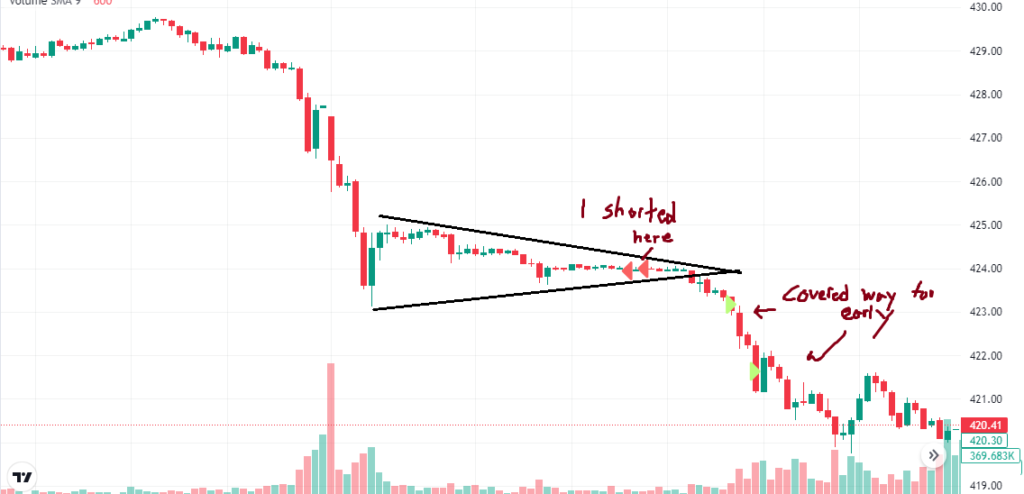
The desk picked their spots. AAPL would soar past $500. We weren’t trying to pick the top of all tops but just catch waves of profit selling when the trend exhausted. I remember Tuco and some of the traders attacking short when AAPL would gap green, crater to fill said gap, and then trade red later in the day. Confidence started to brew and traders encouraged each other to get bigger on the next setup. Me? Well… if you think I felt anxious when trading AAPL on a tiny range with minimal risk, how do I think felt when AAPL had a volatile range demanding several points of risk? I couldn’t pull the trigger and it killed me to be left out.
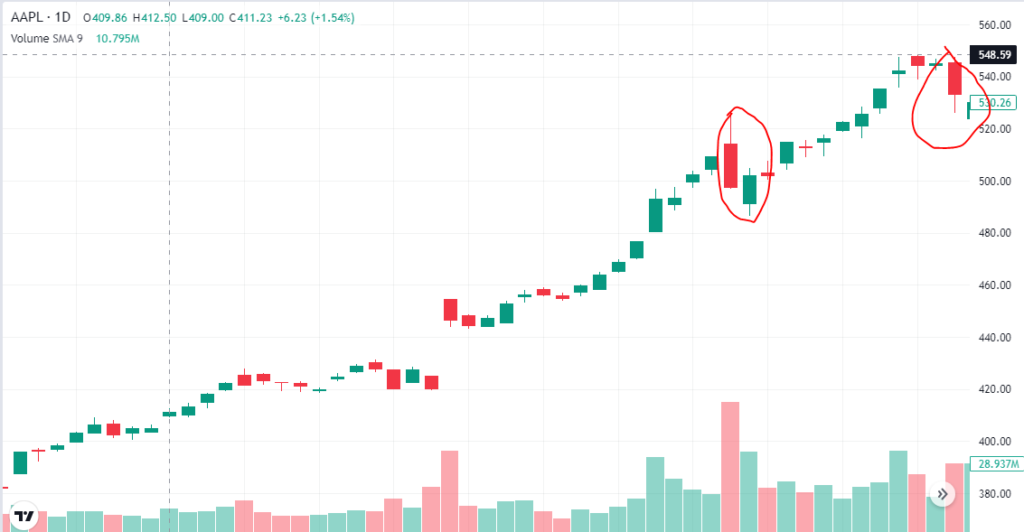
Later in March, AAPL finds the $600 handle. It’s just wild that it refuses to pullback for longer than 1 day. Eagle trades it from the opening bell and calls out some early weakness. It fails to hold $600 and starts to struggle around VWAP levels. Sensing another early plunge, Eagle boldly declares he’s at his max position short. Tuco, not wanting to be upstaged as the head trader, doubles his size. Several others follow their lead and they discuss potential targets. I hesitate because I still did not want to risk multiple points on my stop. I’m trading at peak anxiety because my mind has to deal with two terrible outcomes: 1) take a large loss early or 2) miss out on a huge move and feel left out again. I engage in a little self-talk: Pete, come on, it’s been such a great stock for everyone. It went from $400 to $600 in a couple months. It could plummet. As I try to summon my fortitude, AAPL starts to trade under 595 as sellers exhaust early dip buyers. I place an order near 596, convincing myself I can get a good print rather than chasing the bid.
…a minute later it drops out 12 points. I didn’t get filled.
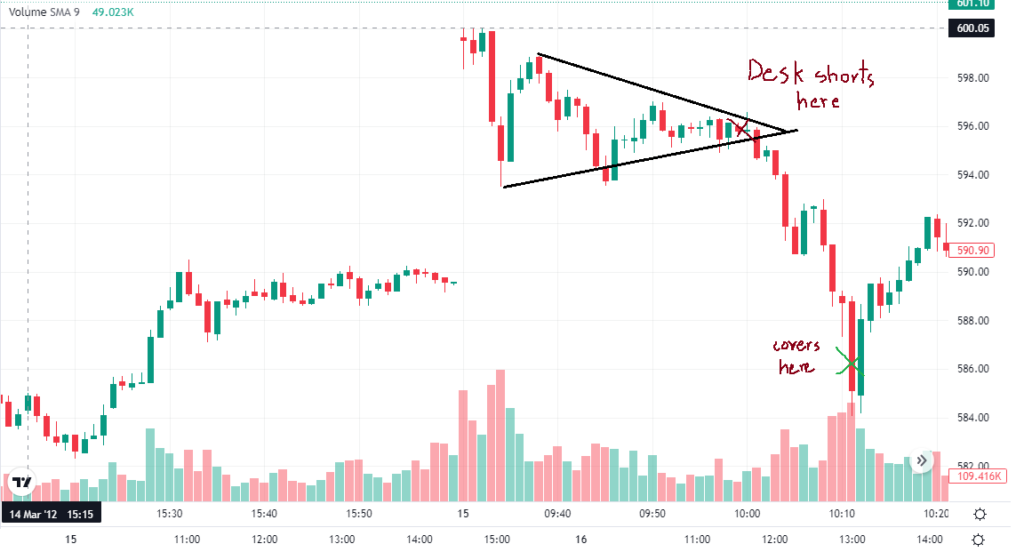
Our traders cover their positions into the washout as AAPL goes negative for the day. A few traders cross 4-figures for the first time. Clockwork got in too and he shared the same weaknesses I had–not wanting to take risk in volatile ranges. Somehow even he found the courage to push the button. Eagle shatters his career best day, up over $3000 before 11am. Tuco is up at least five and holding a small core for more downside. There’s a bit of celebration and backpatting. I hear a GREAT JOB EVERYONE! and a FUCK YEAH WHAT A CALL! Victor makes his round through the desk to commend Eagle for stepping up and fist bump whoever else cashed in. Tuco tells everyone to not feel too satisfied and to re-focus on more downside later in the day. Finally, hard effort had led to progress. At least for some.
I just start staring at the ceiling… trying to pretend everything is okay. Don’t get mad. I try to talk myself through it: Missed trades happen. Professional traders understand that. I miscalculated on my order placement price and it didn’t take, it happens. You could even say I got unlucky. It wasn’t like I chose to completely pass on it. Missed trades happen. Just hit the next one, you’ll know next time. Missed trades happen. You idiot.
Don’t fool yourself. You really thought you could be the Jeremy Lin of trading?! Give me a break! You’ll never make it out here. Everyone got short AAPL and just had their best day. Except you. They all did something you could not, therefore something is abysmally wrong with you. Why did you even move here and trade on a desk? You should have just stayed at home. Missed trades happen. Yeah, happens all the time to losers who are too scared to push the button. You collosal, worthless, COWARDLY idiot.
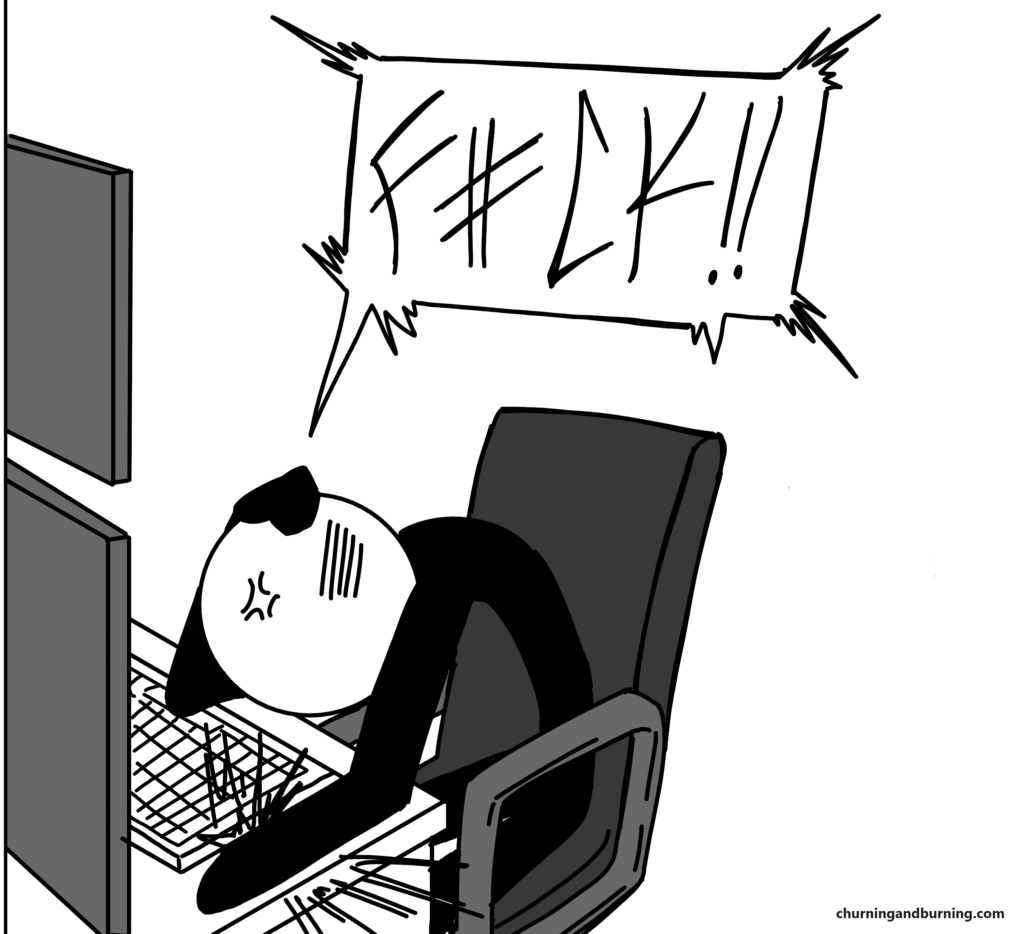
Oh shit. I yelled that outloud.
I got up. I scuttled out quickly so nobody could read my face and see the obvious pain I was in. While I took my walk of shame across the Y5 hallways, I would peer through the numerous glass doors into other offices–people I didn’t know, firms I never heard of, all hunched together looking at all the flashing numbers on their multiple monitors. I wonder if they were crushing AAPL too. So volatile yet so liquid and readable… a perfect trading stock. They’re probably crushing it. Everyone’s making money except me.
I went to the nearest McDonalds. I ordered my usual combination of 10 piece McNuggets, french fries, and a Coke. One Sweet’N’Sour and one BBQ sauce. Comfort food. I dumped myself on a park bench in Bowling Green and ate the pain away, asking myself tough questions like…
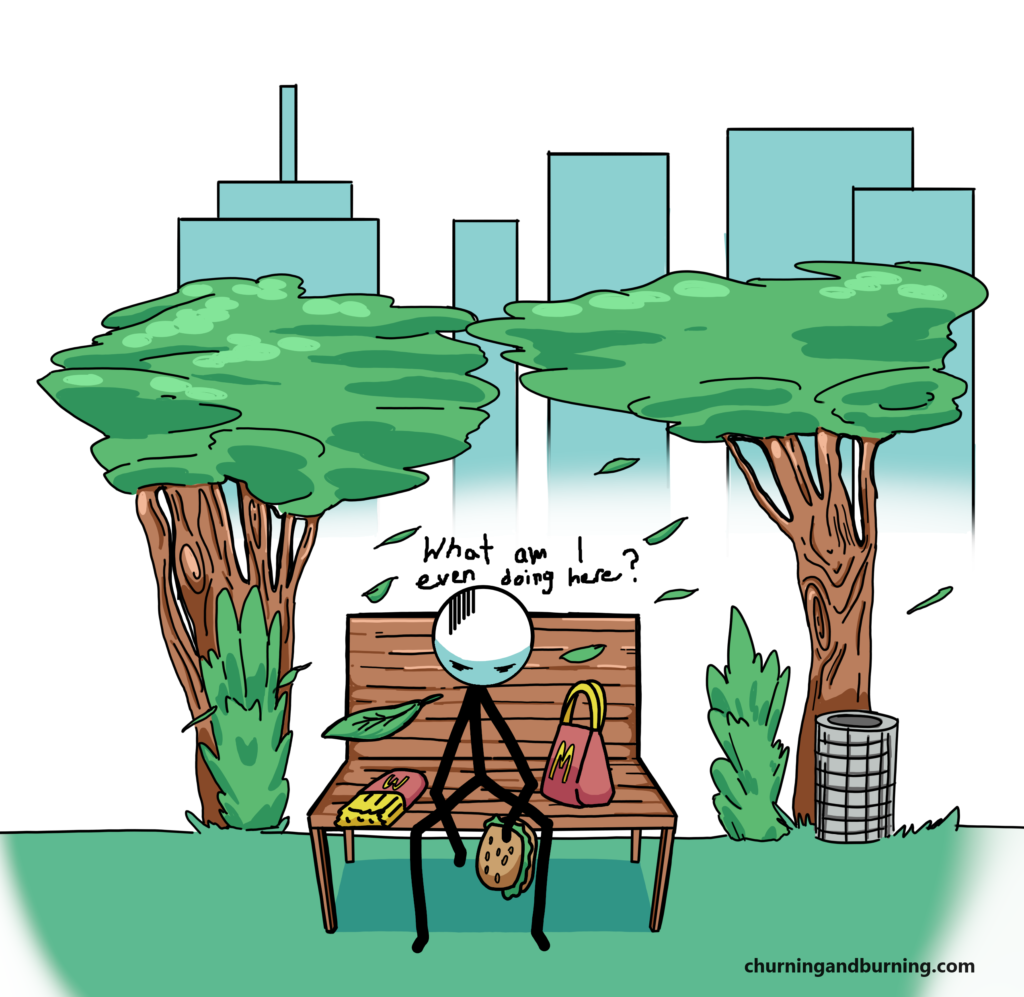
Weirdly, I started to smirk and shake my head. Negative self-talk started to turn into… something else. Not exactly positive but this off-beat “whatever, we’re at where we’re at now” ambivalence. I can’t just rot away in self-pity. Lose a few grand and blow up if you have to. What’s the alternative? To go out all sad like this? I decided I have to do something.
I got back to my desk half past noon and everyone was still trading AAPL in the relentless pursuit of stacking more gains. I asked my buddy Clockwork to update me and he tells me the desk is now short on this bear flag pattern expecting continuation downside into the close. Okay, here’s my second chance: short with 3 point stop, maybe make 10 points later. I didn’t want to act slowly like last time. I had shut down my MBC platform out of rage but my Interactive Brokers personal account (PA) still ran on my laptop.
I hit 200 shares in my PA at $591. Almost immediately, AAPL drops 3 points to $588. I am up $600. That amount would have exceeded my best personal gain on my MBC account. I don’t even think of locking in partial profit because I’m in this state of mind where my prior emotions are dictating my desires. Call it entitlement. It’s superseding that skittish “can’t pull the trigger” anxiety. I don’t want 3 points when everyone else got 10 earlier. I deserve just as much. Then AAPL bounces back to my entry point and I wonder if I’m going to regret everything.
It’s just a blip. It trades there for a few seconds before head back south, tumbling to new intraday lows. I cover 1/4th at 586 and then the rest in the low 580s. Close enough. I lock in close to $1500 in profits. I get to keep all of it.
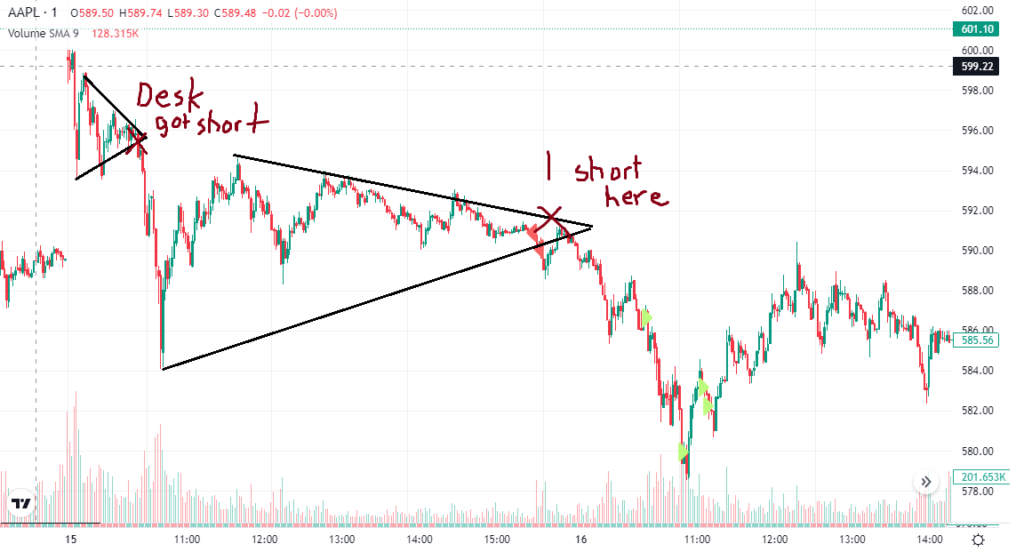

For whatever reason, I felt more comfortable with the risk in my PA. Maybe it was the mental memory of the trades I made in college. Maybe it was because I didn’t feel “seen” by the rest of the desk on my PA. Not seen and not judged. Maybe I cared too much about what others thought of me and felt this nebulous sense of social risk on top of the financial risk of every trade. It’s hard to pinpoint exactly what it was but my mind made a note of these mental differences and this would be important later on.
The desk had its best day in a long time. Some traders even doubled their opening gains, bucking the trend of our desk sitting on early profits and shying away from risk in the afternoon. Victor ordered pizza for all to celebrate. Even the normally stuffy Avery was getting all buddy-buddy with us and chatting hoops! They gotta trade Melo and build around Lin, he pontificates. I’m just relieved to prove to myself, at least for a day, that I wasn’t a fraud. At least I got my piece of that trade.
The next morning, I remember feeling absolutely elated coming into the office. Yesterday’s extreme emotions were a one-off. It’s over now. I conquered the demons. I strutted into the elevator with my hip-hop motivation playlist on full blast. Finally we were all going to make serious money. If I average $1000 a day for the rest of the year, I’ll easily crack six figures. I know I can do it. The music is hitting hard and I’m bobbing and grooving because it’s game time and then I–
STOP IMMEDIATELY because someone holds the door…
…and it’s this cute Asian girl strolling in, instantly radiating the dim fluorescent atmosphere and catching my attention. She doesn’t push a button. She’s going to the 25th floor with me. My heart starts to flutter. Who is she??? There weren’t any women on our desk. Was she new? Another firm? My mind started to race through all kinds of things to say, the exact right thing to get her attention but not seem like a desperate creep. A joke? A compliment? Hurry up you idiot, there’s only a few floors left, stop thinking and just say something already!
“Uh… so… did you trade AAPL?”
(to be continued in Camaraderie)

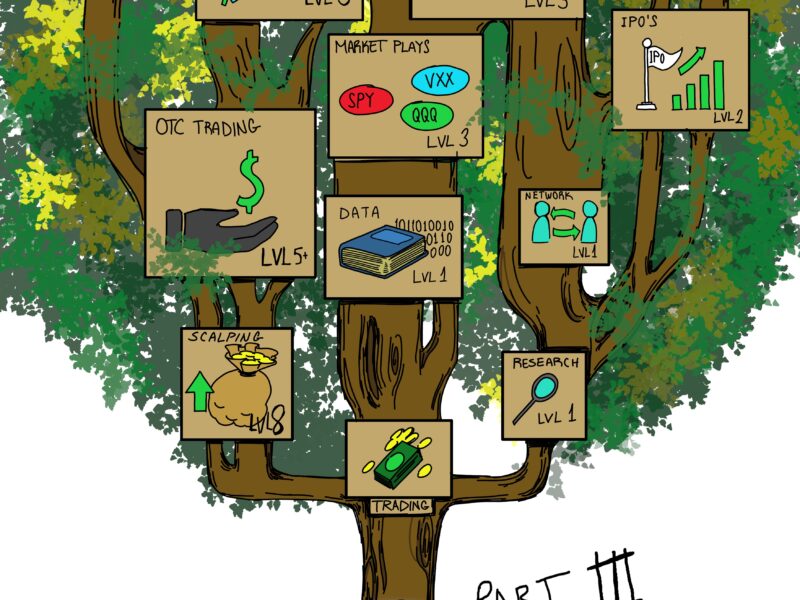


Hey Pete,
Would love to connect with other pro traders, my win rate has been consistently around 80%, I am dying to have someone to chat about the market and be buddies.
Hey Will–feel free to DM me on Twitter @peterkto
Hi Will, fellow full-timer here. Happy to connect. Here’s my twitter handle. @tradethenow. Great article Pete, thanks sharing!
I’m a new trader and I very much enjoy reading your blog posts.
Thank you for creating this.
Reading your stories and experiences is helping me become a better trader.
Do you plan on continuing this story?
Yes I do I’ve just been on vacation. Thanks for reading 🙂
Nothing brings me more joy these days than these posts. Not just that, but reading some of them has been literally trader therapy for me. I can’t thank you enough.
That was a nice comment, thank you 🙂
I love all of this, I see myself when I read your stories. I am about the same age as you were when you started at this prop firm MBC and this blog is the best thing ever. I am just a retail trader and not trading for a desk and I have the same” young guy trying to make it emotions and expectations” as you had when you where just starting out. This is a very nice context that I get to learn about someone who have done the journey I have dreamed of doing and yeah, great therapy. Your the best
thanks for reading!